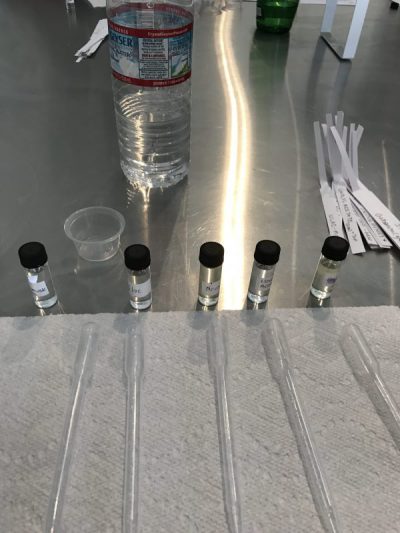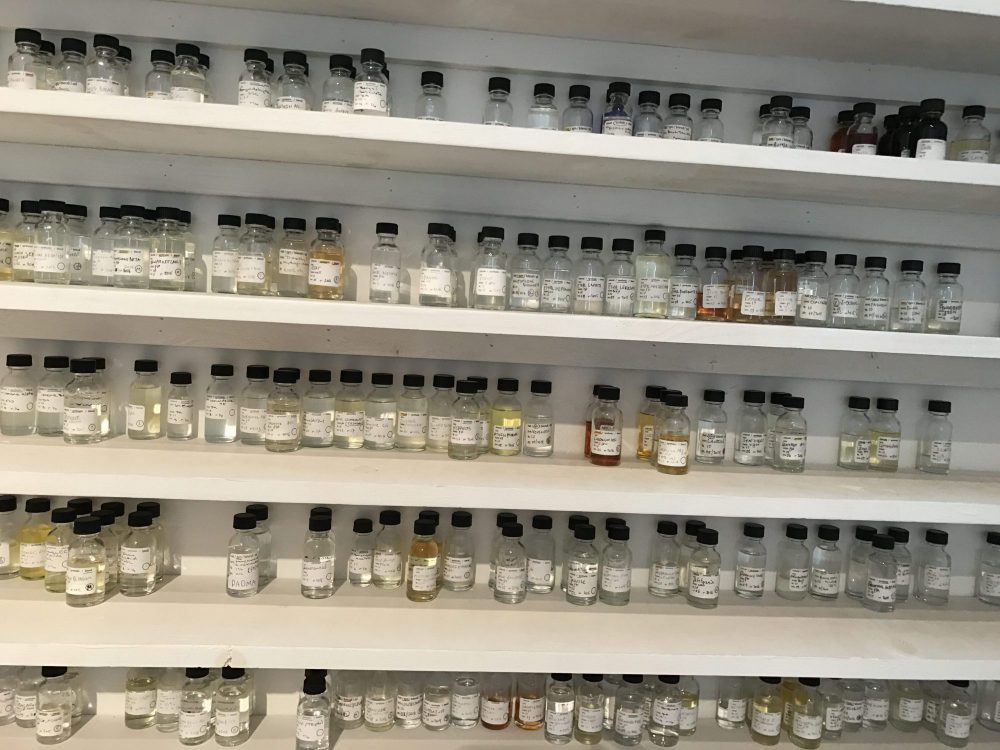Do you dream of making your own personal perfume blend but don’t know where to start? Well that was me until last week when I received an email inviting me to a Beginners Only perfume making class offered by the Institute for Art and Olfaction in LA.
The 3-hour session promised to teach the very basics of perfumery, provide an opportunity to smell a broad selection of aromatic materials, and allow each attendee the opportunity to create their own perfume amongst fellow novices. Everyone would leave with a 4 ml spray vial and a healthy understanding of working with scent.
Perfect!
Timing is everything and I think that I managed to snag the last of the 12 available seats.
YAY!!!
I arrived at the address shown on the email early, which was a good thing since the place is next to impossible to find. It’s actually a small studio located in a narrow alleyway in Chinatown that’s not visible from the street. I happily settled into my seat next to the other females whose taste in fragrance ranged from floral to transparent woods to dirt (I kid you not and that was the gal seated next to me).
The class was taught by Saskia Wilson-Brown, founder of the Institute of Art and Olfaction, and she started us off with a broad overview of the history of modern perfumery, beginning with Louis XIV, and general info about the perfume industry today. Saskia peppered it up along the way with entertaining stories and little known facts to keep it from getting too academic.
Next was the “smell” part aka the part I was here for. To prevent total bedlam from occurring if we were allowed the freedom to pick our own notes from the hundreds available, Sakia narrowed our options down to 12 notes commonly used in fragrances. We all had a chance to sample top notes of bergamot, mandarin aldehyde, tomato leaf and linalyl acetate; middle notes of fig, lilac, rose and neroli; and base notes of Texas cedar, Iso E Super, Terrasol and white musk accord.
Saskia also threw in some unique scents to try like cumerin and galbanum , including some awful smelling ones like indole (rotten floral) and civet (bad breath). Oh yes, she also passed around some ambergris (vomit from sperm whales) for us to get a good whiff of. Not for me, thanks!
The last part of the class was when it got super fun. Finally it was time to create our own custom scents. We were told to select 5 of the notes previously sampled and from there we were free to start creating. We had 8 tries to produce combinations from our  selection, starting with 5 drops of each scent to start. Everyone was free to play around with our blends, experimenting as we saw fit. We recorded each mixture by dipping a testing strip into it and labelling it so we could pick our favorite blend (the one we wanted to leave with) at the end of class. We also recorded the precise number of drops of each ingredient used in every trial so our recipes were recorded for future use.
selection, starting with 5 drops of each scent to start. Everyone was free to play around with our blends, experimenting as we saw fit. We recorded each mixture by dipping a testing strip into it and labelling it so we could pick our favorite blend (the one we wanted to leave with) at the end of class. We also recorded the precise number of drops of each ingredient used in every trial so our recipes were recorded for future use.
Granted, I wasn’t exactly thrilled with my first few attempts, but by around the sixth try I was getting close. Very exciting! I was making progress 🙂 I ended up going with #7 as my favorite.
Of course we were busy trading notes with classmates as we went along, trying to be honest when asked for our opinion about someone else’s concoction. Luckily no catfights ensued amongst our lipstick league.
I wasn’t expecting to leave with a perfume that really wowed me after my perfume making class but what do you know, I actually did. Clean, light and crisp: just what I was hoping for! It even I’ve already tested my creation on a couple of friends and family members who also really liked it. OK they are obviously biased but still.
Coming up with a name was harder than you’d think since just about everything has already been taken. I managed to finally decide on one which will remain secret for now. I’m sure you get why:-)
If the idea of creating your own perfume sounds like intriguing it’s helpful but not necessary to take a class to learn how. The easiest way to go about it in lieu of taking a class is to order a perfume making kit on Amazon which comes with basic instructions on blending. Pretty bottles can also be purchased online.
If you’ve continued reading up to this point you are at the very least intrigued with the idea of DIY perfume.
I dare you to give it a try! You will have fun! For those willing to share your results please leave a comment below 🙂


Greetings Erica,
I’m in agreement: timing is everything.
Just last Saturday, I sat at my kitchen table with two friends discussing…you guessed it, scents! One of them had recently bought 24-case of scents that she was so excited about! I have no doubt that she would be intrigued by your article, especially since she’s moving towards making a lot of things herself.
I love creating things, so the idea of creating my very own fragrance sounds delightful!!!
Hello Veronica,
There seems to be a movement in that direction, which I suspect is partly due to the high cost of perfumes (especially niche perfumes) and also the fact that raw materials can be purchased so easily online. Both you and your friend should remember that not everything sold online is what it claims to be… so make sure to buy from a reputable source. Tip: read the reviews of the sellers on Amazon before buying.
I hope you decide to give it a try since you love creating things. You’ll not only have fun with it but hopefully also end up with something that you adore:)
Erica
That sounds like a really fun class! When you talk about notes, are you talking about specific essential oils, or the ingredients? I know I’ve used essential oils in the past as perfumes. But it probably wasn’t nearly as good as what you made! Hopefully one day we find out your secret ingredients to your perfume:)
Hi Elsa,
We were working with simple plant extracts and aromachemicals like ISO E Super and phytochemicals like Linalyl Acetate, which is one of the principal components of the essential oils of bergamot and lavender. I have an appreciation for essential oils too but this was the class agenda.
Find out my secret recipe? Not a chance my dear:)
Thanks for stopping by!
Erica